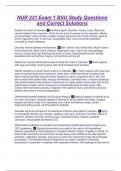NUR 231 Exam 1 BSU Study Questions
and Correct Solutions
Explain the chain of infection ✅Infectious agent: bacteria, viruses, fungi. Reservoir:
natural habitat of the organism. Portal of exit: point of escape for the organism. Means
of transmission: direct contact, indirect contact, airborne route. Portal of entry: point at
which organisms enter a new host. Susceptible host: must overcome resistance
mounted by host's defenses.
Describe normal defense mechanisms. ✅Skin- barrier and normal flora, Mouth- saliva
and normal flora, Eyes- tears, blinking, Respiratory tract- cilia lining, macrophages,
mucus, Urinary tract- pH and flushing action of urine, Gastrointestinal tract- acidity,
peristalsis and normal flora, Vagina- normal flora and low pH
Determine nursing interventions used to break the chain of infection. ✅Hand hygiene
with soap and water, hand hygiene with alcohol based hand sanitizer.
Identify situations in which hand hygiene is indicated. ✅1. Hand hygiene with soap and
water should be done when hands are visibly dirty, soiled with blood or bodily fluids,
before eating and after using the toilet, exposure to spore organisms like C-diff, and
after contact with bodily fluids, mucous membranes, nonintact skin, or wound dressings.
Use alcohol based hand sanitizer if hands are not visibly soiled, before after and during
patient direct contact, when moving from contaminates area to clean areas, after
contact with inanimate surfaces or objects in the patient's room, and before caring for
patients with severe immune suppression.
Differentiate between Medical and Surgical Asepsis ✅Medical asepsis is referred to as
the clean technique. Surgical asepsis is referred to as the sterile technique. Surgical
asepsis should be used in an operating room, labor and delivery areas, certain
diagnostic testing areas, and the patient's bedside.
Describe signs and symptoms of acute/local infection and systemic infection. ✅Signs
of acute/local infection are redness, swelling, heat, pain, and loss of function. Signs of
systemic infection are fever (primary sign), nausea/vomiting, malaise, possible
confusion, and possible decreased LOC.
Differentiate strategies for standard and transmission-based precautions based upon
CDC guidelines. ✅Standard precautions are used in the care of all hospitalized
patients regardless of their diagnosis or possible infection status. It applies to blood, all
body fluids, secretions and excretions except sweat. New additions are safe injection
practices, respiratory hygiene, and using a mask when performing high-risk prolonged
procedures. Transmission-Based Precautions are used in addition to standard
precautions for patients in hospitals with suspected infection with pathogens that can be
, transmitted by airborne, droplet, or contact routes. Guidelines include PPE when
entering the room of a patient on contact or droplet precautions. If on droplet
precautions keep visitors 3 feet away from the infected person.
Explain proper use of PPE's especially in correlation with COVID-19 precautions. ✅A
face covering might not protect the wearer but may keep the wearer from spreading the
virus to others. COVID 19 spreads primarily through respiratory droplets when an
infected person coughs, sneezes, or talks.
Identify purposes of bathing. ✅Purposes of bathing: cleanses the skin, helps to relax a
person, promotes circulation, serves as musculoskeletal exercise, stimulates the rate
and depth of respirations, provides person with sensory input, helps improve self-image,
and strengthens nurse-patient relationship.
Describe factors affecting personal hygiene. ✅Factors affecting personal hygiene:
culture, socioeconomic class, spiritual practices, developmental level, health status, and
personal preferences.
Demonstrate hygiene guidelines implemented with every patient. ✅Assist patient with
toileting, provide comfort measures to refresh patient, wash face and hands, provide
mouth care, bathing, back massage, special skin measures, hair care, dressing,
positioning for comfort, tidying up bedside, change soiled linens or clothing, ensure call
light is within reach.
Describe assessments to be performed during hygiene care. ✅Assess lips, buccal
mucosa, color and surface of gums, teeth, tongue, hard and soft palates, and
oropharynx.
Describe environmental hazards that pose risks to a person's safety. ✅Falls- one in
four of people over 65 fall every year. Fire- 80% of all fire deaths occur in the home.
Poisoning- more than 59,000 children are treated for accidental poisonings each year
most often from accidental ingestion of meds of family members. Suffocation/Choking-
suffocation or asphyxiation can occur at any age but is most common in children.
Firearms- intentional injuries caused by firearms are a leading cause of death in
children.
Identify the factors to assess when a patient is in restraints. ✅•Restraints are physical
devices that restrict movement.
•Can be physical or chemical
•Restraints must only be used to protect the patient, staff, or others and only as a last
resort
•Must be discontinued as soon as possible
•Explore any and all alternatives to use of restraints




